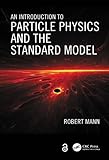An Introduction to Particle Physics and the Standard Model.
Material type: TextPublisher: Hoboken : CRC Press, 2009Description: 1 online resource (602 pages)Content type:
TextPublisher: Hoboken : CRC Press, 2009Description: 1 online resource (602 pages)Content type: - text
- computer
- online resource
- 9781420083002
- 1420083007
- 539.7/2 539.72
- QC793.2 .M36 2012
Print version record.
Front cover; Contents; Preface; Acknowledgments; Further Reading; Chapter 1. Introduction and Overview; Chapter 2. A Review of Special Relativity; Chapter 3. Symmetries; Chapter 4. Conservation Laws; Chapter 5. Particle Classification; Chapter 6. Discrete Symmetries; Chapter 7. Accelerators; Chapter 8. Detectors; Chapter 9. Scattering; Chapter 10. A Toy Theory; Chapter 11. Wave Equations for Elementary Particles; Chapter 12. Gauge Invariance; Chapter 13. Quantum Electrodynamics; Chapter 14. Testing QED; Chapter 15. From Nuclei to Quarks; Chapter 16. The Quark Model.
Chapter 17. Testing the Quark ModelChapter 18. Heavy Quarks and QCD; Chapter 19. From Beta Decay to Weak Interactions; Chapter 20. Charged Leptonic Weak Interactions; Chapter 21. Charged Weak Interactions of Quarks and Leptons; Chapter 22. Electroweak Unification; Chapter 23. Electroweak Symmetry Breaking; Chapter 24. Testing Electroweak Theory; Chapter 25. Beyond the Standard Model; Appendix A. Notation and Conventions; Appendix B. Kronecker Delta and Levi-Civita Symbols; Appendix C. Dirac Delta-Functions; Appendix D. Pauli and Dirac Matrices; Appendix E. Cross-Sections and Decay Rates.
Appendix F. Clebsch-Gordon CoefficientsAppendix G. Fundamental Constants; Appendix H. Properties of Elementary Particles; Appendix I. Feynman Rules for the Standard Model; Appendix J. The Large Hadron Rap; References; Back cover.
... thoroughly recommended for a final-year specialist or first-year postgraduate study level especially for those engaged in experimental high energy physics research. The author has performed an excellent service in making accessible the language and results of field theory applied to elementary particle physics.-John J. Quenby, Contemporary Physics, 52, 2011The first chapter shows how clearly the author can write and even though the subject matter gets more complex through the book, the clarity continues. ... giv[es] readers greater insights into how the maths and the reality match (or don't ma.
Includes bibliographical references and index.
WorldCat record variable field(s) change: 072

There are no comments on this title.